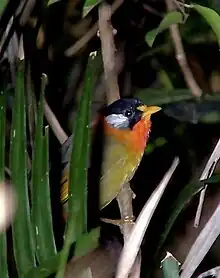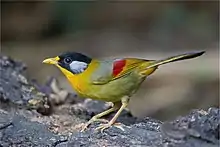| Leiothrix | |
|---|---|
 | |
| Silver-eared mesia Leiothrix argentauris | |
| Scientific classification | |
| Domain: | Eukaryota |
| Kingdom: | Animalia |
| Phylum: | Chordata |
| Class: | Aves |
| Order: | Passeriformes |
| Family: | Leiothrichidae |
| Genus: | Leiothrix Swainson, 1832 |
| Type species | |
| Parus furcatus[1] = Sylvia luteo Temminck, 1824 | |
| Species | |
Leiothrix is a genus of passerine birds in the family Leiothrichidae. They belong to a clade also containing at least the liocichlas, barwings, minlas and sibias. The sibias are possibly their closest living relatives.
Taxonomy
The genus Leiothrix was introduced in 1832 by the English naturalist William John Swainson with the red-billed leiothrix as the type species.[2][3] The genus name combines the Ancient Greek leios meaning "smooth" and thrix meaning "hair".[4]
The genus contains two species:[5]
| Image | Scientific name | Common Name | Distribution |
|---|---|---|---|
 | Leiothrix argentauris | Silver-eared mesia | South East Asia. |
 | Leiothrix lutea | Red-billed leiothrix or "Pekin nightingale", | India, Bhutan, Nepal, Burma and parts of Tibet. |
Their delicate colors and accomplished song make them popular cagebirds.
References
Wikimedia Commons has media related to Leiothrix (Aves).
Wikispecies has information related to Leiothrix (bird).
- ↑ "Leiothrichidae". aviansystematics.org. The Trust for Avian Systematics. Retrieved 2023-07-15.
- ↑ Swainson, William John; Richardson, J. (1831). Fauna Boreali-Americana, or, The Zoology of the Northern Parts of British America. Vol. 2: The Birds. London: J. Murray. pp. 233, 490. The title page bears the year 1831 but the volume was not published until 1832.
- ↑ Mayr, Ernst; Paynter, Raymond A. Jr, eds. (1964). Check-List of Birds of the World. Vol. 10. Cambridge, Massachusetts: Museum of Comparative Zoology. p. 381.
- ↑ Jobling, James A. (2010). The Helm Dictionary of Scientific Bird Names. London: Christopher Helm. p. 221. ISBN 978-1-4081-2501-4.
- ↑ Gill, Frank; Donsker, David; Rasmussen, Pamela, eds. (January 2022). "Laughingthrushes and allies". IOC World Bird List Version 12.1. International Ornithologists' Union. Retrieved 6 June 2022.
- Cibois, Alice (2003): Mitochondrial DNA Phylogeny of Babblers (Timaliidae). Auk 120(1): 1-20. DOI: 10.1642/0004-8038(2003)120[0035:MDPOBT]2.0.CO;2 HTML fulltext without images
- Collar, N. J. & Robson C. 2007. Family Timaliidae (Babblers) pp. 70 – 291 in; del Hoyo, J., Elliott, A. & Christie, D.A. eds. Handbook of the Birds of the World, Vol. 12. Picathartes to Tits and Chickadees. Lynx Edicions, Barcelona.
This article is issued from Wikipedia. The text is licensed under Creative Commons - Attribution - Sharealike. Additional terms may apply for the media files.